Tuesday, March 1, 2020 – HIGH ABOVE WASHINGTON HEIGHTS THIS HISTORIC TOWER HAS A LONG HISTORY


TUESDAY, MARCH 1, 2022
610th Issue
SECRETS OF THE
HIGHBRIDGE
WATER TOWER
FROM: UNTAPPED NEW YORK
JFFF REUBEN

The 200-foot tall Highbridge Water Tower in Washington Heights stands on a bluff above the High Bridge and Harlem River, sharing a park landscape with a swimming pool, baseball field, playground, terrace, and lawns. It is a familiar, if somewhat mysterious landmark for local residents, MetroNorth Hudson Line commuters, and motorists on the Harlem River Drive and other nearby roadways and bridges.
However, when it was completed 150 years ago, its setting and function were quite different. Constructed as an addition to the Croton water system in a then thinly populated area, it was a major catalyst in the transformation of Upper Manhattan into bustling urban neighborhoods.
For many today, its origins and historic role are unknown, but it is time to rediscover this enigmatic icon, which is not only celebrating its sesquicentennial in 2022, but was also recently reopened for tours following a $5 million restoration. In celebration of its return to the spotlight, we present ten secrets of this distinctive structure.


NYC Department of Public Works, Annual Report, 1872. Public domain
When the Croton Aqueduct opened in 1842, providing Manhattan with an abundant source of clean drinking water, the system relied on gravity for water pressure. As a result, northern Manhattan was not served by the system given that much of it is at elevations higher than the reservoirs in Central Park and at 42nd Street. A bit ironic considering that the High Bridge, which carried the aqueduct over the Harlem River., became a defining feature of the area and a popular destination for visitors following its completion in 1848.
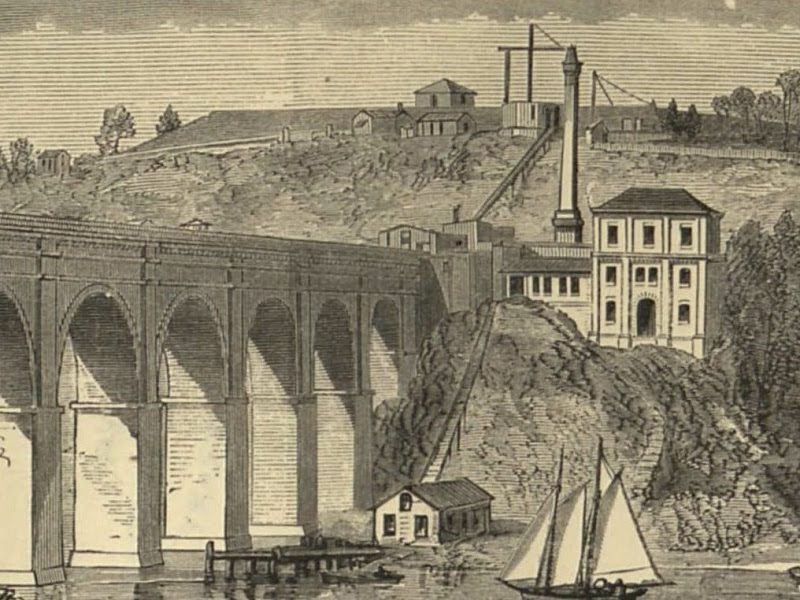
The Technologist, Aug. 1870. “High Service Water Works.” (Tower under construction)Public domain
In an era when individual buildings did not have their own water pumps and tanks, a systemic solution was needed. So, the City’s Croton Aqueduct Department added the High Service Water Works to “cure the evil of limited supply to those whose ambition brought them above the level of the reservoir” as the New York Times elegantly phrased it in 1866. The site selected for these facilities was high ground near the Manhattan end of the High Bridge.

Appletons’ Journal, July 6, 1872.Public domain
The Water Tower was just one part of this. As shown in the historic images above, next to it was a reservoir, opened in 1870, with a storage capacity of nearly 11 million gallons. It was high enough that it provided water pressure to serve 90 percent of the High Service Area; water pressure for the other 10 percent was provided by a 47,000-gallon water tank located inside the Tower.
Next to the High Bridge, there was also a pumping station with a steam engine, boiler, and smokestack to force water up from the aqueduct, a coal dock and shed along the waterfront, and an inclined plane to lift coal up the steep river bank to the pumping station. All except the Tower no longer exist, nor does another pumping station added in the mid 1890s about 1,000 feet to the north.

Morris-Jumel Mansion
Describing the High Service Water Works plans, the New York Herald reported in 1864 that “this is to be done by means of a tower erected on Madame Jumel’s property, at High Bridge.”
This is a reference to Eliza B. Jumel, the American-born widow of French merchant Étienne (anglicized to Stephen) Jumel and ex-wife of Aaron Burr. Residing nearby in the Morris-Jumel Mansion, now a museum, she owned extensive real estate holdings including about seven acres where the City wanted to locate the High Service Water Works.

She offered this land for about $79,000, “to avoid the expenses which the City would necessarily have to incur to ascertain the value of the property.” The City rejected this and pursued an eminent domain taking, resulting in a Court approved compensation of $45,000. This substantial price reduction was a moot point for Madame Jumel; the process was completed in December 1865, six months after she passed away at age 90.
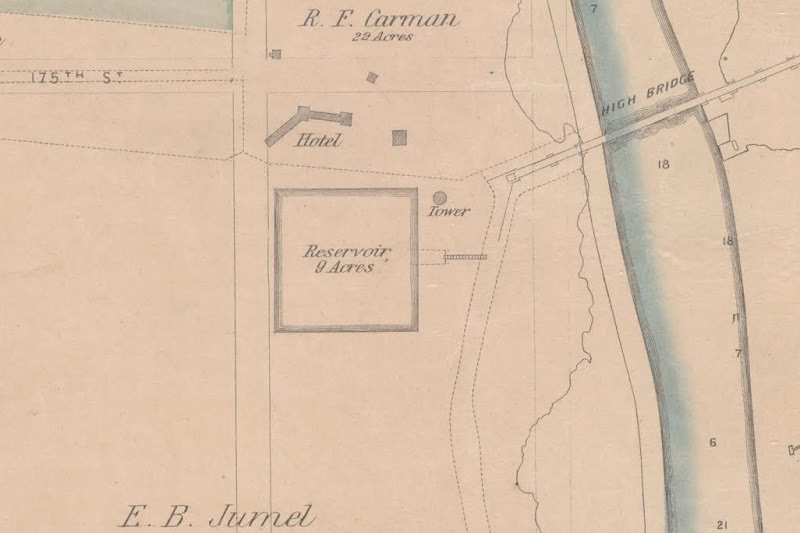
The map above from 1867 shows where the Water Tower and reservoir were to be placed and also indicates property boundaries (dashed lines) prior to the taking, including Jumel’s lands and the City’s aqueduct corridor extending south from the High Bridge.
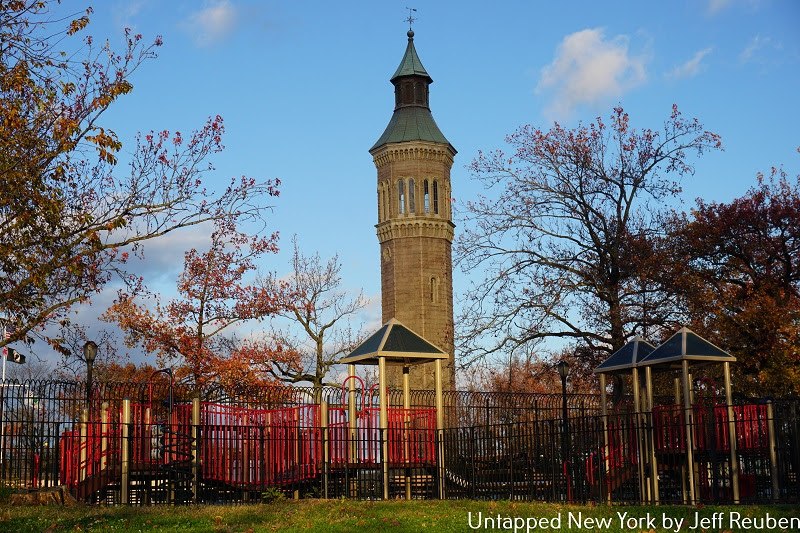
WHO DESIGNED IT?
Identifying who designed the Highbridge Water Tower is a matter worthy of attention, not least because many sources have credited it to the wrong person.
Contemporary accounts state that the High Service Water Works, including the Tower, were designed under the direction of Alfred W. Craven, who served as the Croton Aqueduct Chief Engineer from 1849 to 1868. Some sources also mention William L. Dearborn, who served as Engineer in Charge from 1862 to 1872. For what it is worth, Dearborn also signed plans for the Water Tower from the early 1870s. “
These extensive works have all been designed under the general direction of A.W. Craven, esq., engineer in chief of the Croton Department, by Wm. L. Dearborn, esq., Engineer in charge.”
New York Tribune, January 14, 1868. “Croton Department: New High-service Reservoir and Water Works at Washington Hights”
However, a century later in 1967 the City’s one-page Landmark Designation report states the Tower is “attributed to John B. Jervis.” One of the giants of American civil engineering history who was Croton Aqueduct Chief Engineer from 1836 to 1848, Jervis oversaw design and completion of the aqueduct and the High Bridge. However, after 1848 he went on to other endeavors and there is no evidence he designed the High Service Water Works. It appears that Jervis’ work on the High Bridge was conflated with the later Tower.
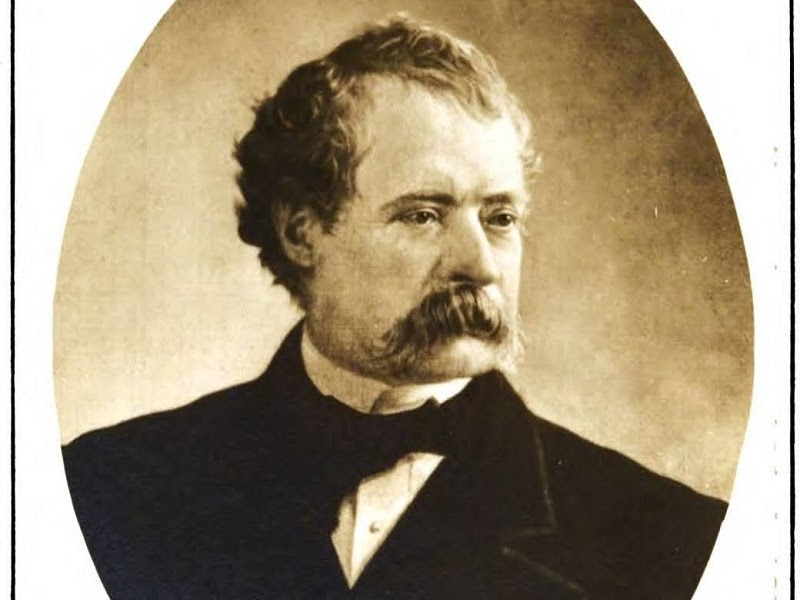
Alfred W. Craven, from Early Columbia engineers, an appreciation. Public domain
In an adult version of the children’s classic “telephone game,” many subsequent sources also state that Jervis designed the Tower, but dropping the “attributed to” qualification. It has become canon.
PART 2 TOMORROW
Tuesday Photo of the Day
SEND YOU RESPONSE TO ROOSEVELTISLANDHISTORY@GMAIL.COM
IF BOUNCED-BACK SEND TO JBIRD134@AOL.COM
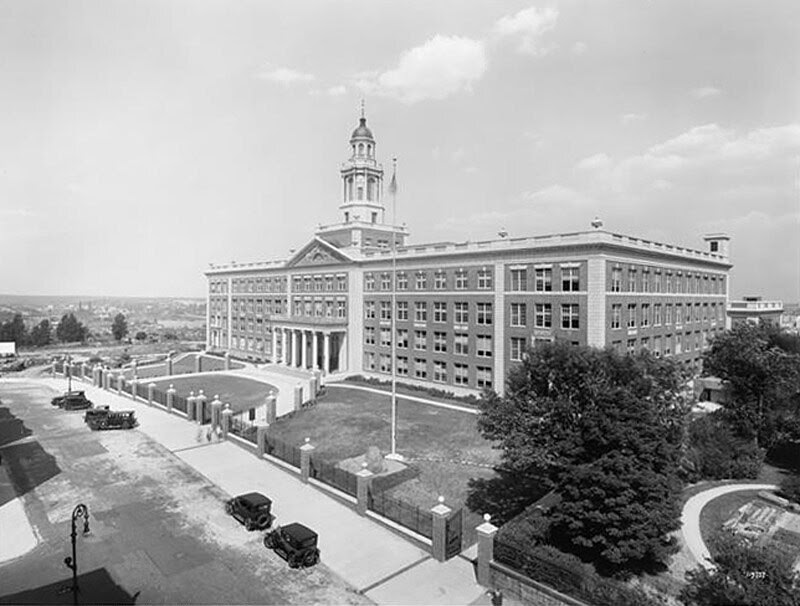
MONDAY PHOTO OF THE DAY
The Blue Dragon Sculptre by Swedish artists Gustav and Ulla Kraitz located on Roosevelt Island near the entrance to Southpoint Park.
LAURA HUSSEY,GLORIA HERMAN , ALEXIS VILLAFANE AND VICKI FEINMEL GOT IT EARLY!!!

from readers:
Not sure if this is a statue made by an amused grandchild of me swimming in the East River, or the wonderful whale statue at the entrance to the South Point Park en route to the FDR Memorial. So sorry to learn of Arline’s death. One of the very wonderful people who have been part of the Rivercross world for many, many years. Do you think that is because of the influence, however subtle, of Nellie Bly?
Regards, Jay Jacobson
Below images are from Arline Jacoby
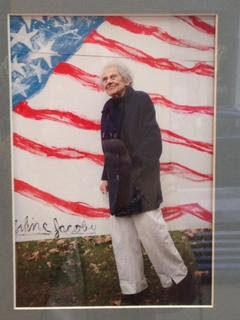
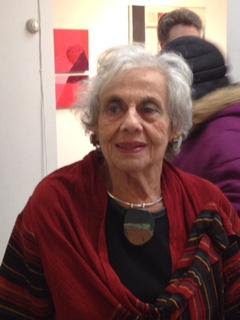
Hi Judy,
Thank you so much for remembering me and sending me the information about Arlene. As I was reading the reflections on her, it brought joyful images to mind of when I was involved with RIVAA> She had so much joy and energy when it came to art. A truly beautiful soul. I can still hear her voice and feel her passion. She will certainly be missed. I will attend the memorial tomorrow. Thanks again and sending hugs and warm wishes for a healthy, joyful year ahead for you.
Best,
Ron Becker, Former Director of Therapeutic Recreation at Coler-Goldwater
Text by Judith Berdy
Thanks to Bobbie Slonevsky for her dedication to Blackwell’s Almanac and the RIHS
Thanks to Deborah Dorff for maintaining our website
Edited by Melanie Colter and Deborah Dorff
All image are copyrighted (c) Roosevelt Island Historical Society unless otherwise indicated
Sources
UNTAPPED NEW YORK
FUNDING PROVIDED BY ROOSEVELT ISLAND OPERATING CORPORATION PUBLIC PURPOSE GRANTS CITY COUNCIL REPRESENTATIVE BEN KALLOS DISCRETIONARY FUNDING THRU DYCD


Copyright © 2022 Roosevelt Island Historical Society, All rights reserved.Our mailing address is:
rooseveltislandhistory@gmail.com

Leave a comment